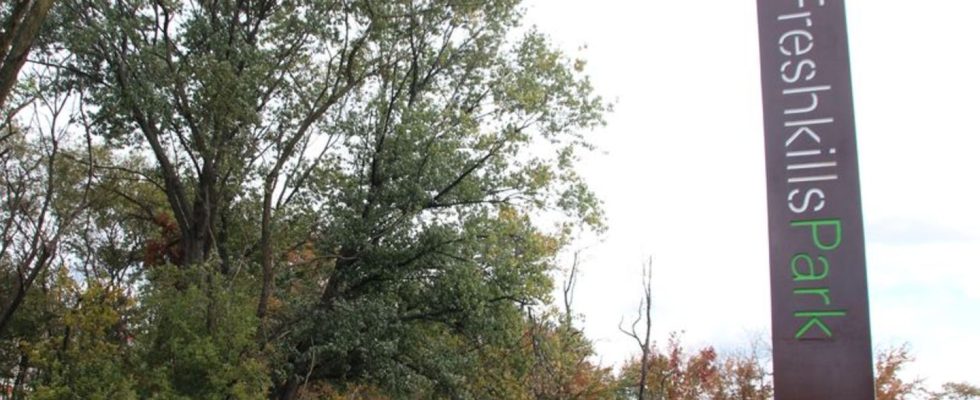“Freshkills”
What was once the world’s largest garbage dump is now a park in New York
The entrance to “Freshkills Park” in New York’s Staten Island – built on the site of what was once the largest garbage dump in the world. photo
© Christina Horsten/dpa
For a long time, New York’s garbage ended up in the Staten Island district – in what was at times the largest landfill in the world. This will now become the huge “Freshkills Park” – and the first section has now opened.
The park isn’t really inviting yet. There are only a few signs. It’s a long way from Manhattan by public transportation. And by car, visitors have to laboriously make their way to a turnoff between the highway, warehouse and hotel in the district on an island off the coast Navigating Staten Island before coming to a large rust-colored pillar: “Freshkills Park.”
Despite the weekend and the sunny autumn weather, there are only a few cars in the parking lot in front – but that will change, says Sue Donoghue, head of the New York City Parks Authority. “This is about the rebirth of a place that has had such negative connotations in the past and now it’s going to be the exact opposite.”
Garbage higher than the Statue of Liberty
For more than 50 years, here in the middle of Staten Island was – according to Donoghue’s authority – the largest garbage dump in the world. A saltwater swamp where children went swimming in the summer was converted into a landfill in 1948. By 2001, a total of around 150 million tons of waste landed there, mainly by ship, mostly from households in the metropolis of New York. The garbage gradually piled up in mountains, sometimes higher than the Statue of Liberty, which towers not far away on another island in New York Harbor.
With the trash came stench, traffic – and a bad reputation for Staten Island, which is still considered by many to be the “fifth and forgotten borough of New York.” Residents of other parts of the city often scoffed that the entire island was a garbage dump. In 2001, the landfill, which activists had been demanding for decades, was closed, with the hope of turning the site into a public park. More than 20 years later, the first section has now opened to visitors. “What was once an eyesore will now be a world-class park,” Mayor Eric Adams said at a recent opening ceremony.
The first section, the “North Mound”, looks at first glance like a normal park: meadows, trees, a lake, a lookout for bird watchers, benches and about a kilometer of paths for walkers and cyclists. According to the official information brochure, there are, among other things, deer, herons, turtles and golden rue here.
No more smell
Only the before photos that the park authority has put up on several display boards make it clear how much has changed here. Heaps of rubbish lay around here, with seagulls and other birds circling above it in search of food. After decades of work by specialists who had to specially seal the mountains of rubbish and, in some cases, make it possible for plants to grow on them, nothing of it can be seen today. It doesn’t even smell like trash anymore.
However, the “North Mound” is just the beginning, only about one percent of the total area that “Freshkills Park” will one day take up – it will be almost three times as big as Central Park. That’s still a lot of work; the entire park won’t be open until 2036. The first section that opened has already convinced many visitors. “This is a great park for cycling,” says one man. “It’s hard to believe that this was once the largest garbage dump in the world.”

